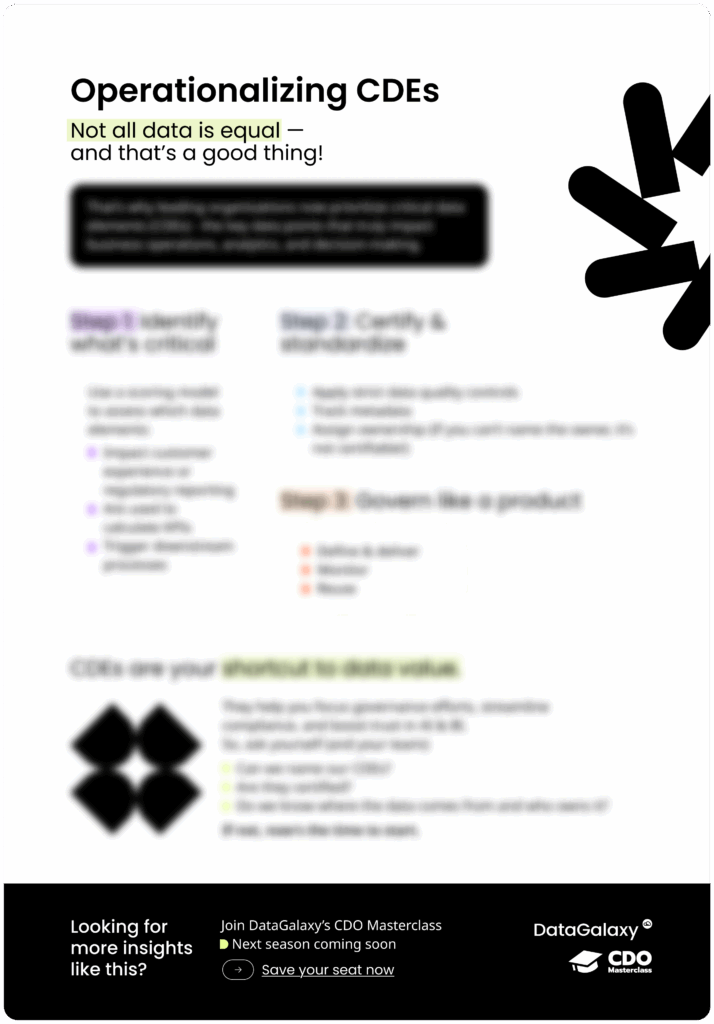
Data mesh architecture & data catalog winning data strategy
Data mesh, a modern architectural and organizational concept that decentralizes data management, aims to overcome the limitations of traditional, monolithic data architectures.
Keep reading to discover the benefits of utilizing a data mesh architecture with a data catalog to create a true data-driven strategy for all your teams.
Data mesh defined
Data mesh is an architectural and organizational data management concept that decentralizes an enterprise’s design, creation, and management of data.
It was inspired by the principles of microservice architecture for software development and aims to treat data as a product with responsibility distributed across multidisciplinary teams.
This approach seeks to overcome the challenges associated with monolithic, centralized data architectures by promoting a culture of collaboration and autonomy.
Key principles of data mesh
Data mesh is based on four fundamental principles:
1. Data as a product
- Concept: Each business area treats its data as a product, with a dedicated team responsible for the quality, accessibility, and usefulness of this data for consumers
- Dedicated ownership: Each business domain or area assigns a dedicated team responsible for the lifecycle of its data from creation to delivery, quality control, maintenance, and enhancements. This team ensures that data is reliable, up-to-date, well-documented, and easy to consume.
- Consumer focus: Teams prioritize the needs of data consumers (which could be other teams or external clients), ensuring the data they provide is useful, understandable, and easily accessible. This product mindset promotes continual improvement based on feedback, just like traditional products.
2. Autonomous domains
- Decentralization of data management: Teams are organized around specific business domains, enabling decentralized, independent data management. This autonomy allows teams to manage their data according to their specific needs and expertise.
- Domain-driven design: Drawing from domain-driven design principles, data mesh advocates for organizing teams around business domains. This structure aligns data ownership and operations with the natural boundaries of the organization, ensuring domain experts are responsible for their data and can independently manage it.
- Independence: Each domain operates independently, meaning teams can make decisions regarding their data models, pipelines, and tooling without being reliant on central data teams. This independence accelerates innovation and flexibility, allowing teams to respond faster to their own requirements.
Operationalizing
CDEs
Do you know how to make critical data elements (CDEs) work for your teams?
Get your go-to guide to identifying and governing critical
data elements to accelerate data value.

3. Data infrastructure as a platform
- Self-service data infrastructure: To support the decentralized management of data, data mesh provides a centralized data infrastructure as a platform. This common platform enables domain teams to easily build, deploy, and operate their data products without needing deep technical expertise in data engineering.
- Reusable tools & services: The infrastructure typically includes services such as data storage, access control, data lineage, quality monitoring, security, and privacy features, so domain teams don’t have to reinvent the wheel. These tools ensure consistent data practices across the organization while removing friction for domain teams.
- Automation & scalability: The platform provides automation to handle routine tasks like data ingestion, transformation, and scaling, freeing up domain teams to focus on their core business functions rather than the intricacies of data management
4. Distributed governance
- Federated data governance model: In contrast to traditional centralized governance approaches, data governance policies are applied in a distributed way, enabling flexibility and adaptation to the specific needs of each domain while maintaining enterprise-wide consistency and compliance.
- Collaboration & shared responsibility: Governance is a shared responsibility, where domain teams collaborate with governance bodies to implement policies in a way that aligns with their specific business needs. This approach balances enterprise-wide consistency with domain-specific flexibility.
Designing data & AI products that deliver business value
To truly derive value from AI, it’s not enough to just have the technology.
- Clear strategy
- Reasonable rules for managing data
- Focus on building useful data products

- Global standards with local adaptation: While governance is distributed, there are still universal standards (e.g., security protocols and data privacy regulations like GDPR) that all domains must follow.
The role of a data catalog in data mesh
Data catalogs play a crucial role in data mesh implementation, providing the tools to facilitate discovery, understanding, and collaboration around data.
Data discovery
Data catalogs provide a search engine and navigation mechanisms to easily find available data across the organization – An essential for teams working in a decentralized environment.
Metadata & documentation
Automatic or manual cataloging of data with rich metadata helps users understand the context, provenance, and quality of data, aligning with the principle of “data as a product.”
Collaboration & sharing
Data catalogs facilitate knowledge sharing and collaboration between teams by enabling users to comment on, evaluate, and discuss datasets.
Governance & compliance
By integrating governance rules and offering views on access and usage, a data catalog helps maintain data compliance and security in a distributed model.
Interoperability
Data catalogs ensure seamless integration with other tools and platforms used by different teams, supporting the data infrastructure as a platform.
Conclusion
In conclusion, the data mesh environment is a promising approach to managing the complexities of modern data environments, promoting agility, collaboration, and autonomy.
A data catalog is essential to realizing this vision, serving as a link between the various domains and providing the tools needed for effective data management as a product.
FAQ
- Do I need a data catalog?
-
If your teams are struggling to find data, understand its meaning, or trust its source — then yes. A data catalog helps you centralize, document, and connect data assets across your ecosystem. It’s the foundation of any data-driven organization.
👉 Want to go deeper? Check out:
https://www.datagalaxy.com/en/blog/what-is-a-data-catalog/ - How do I know if my data is “governed”?
-
If your data assets are documented, owned, classified, and regularly validated — and if people across your org trust and use that data consistently — you’re well on your way.
👉 Want to go deeper? Check out:
https://www.datagalaxy.com/en/blog/choosing-the-right-data-governance-tool/ - How does a data catalog help with AI risk management?
-
A modern data catalog helps identify and track sensitive data, document lineage, and ensure data quality — all of which reduce AI-related risks. It also improves traceability across AI pipelines and enables proactive monitoring.
- How does a data catalog integrate with my existing tools?
-
Modern catalogs integrate with your full data ecosystem — from Snowflake to Power BI. DataGalaxy includes prebuilt connectors, APIs, and automation tools that make syncing metadata seamless and scalable.
👉 See supported integrations - How does a data catalog integrate with Snowflake / BigQuery / Power BI?
-
Through prebuilt connectors and APIs. DataGalaxy automatically ingests metadata from cloud platforms, pipelines, and BI tools to keep your catalog up to date with minimal effort.

